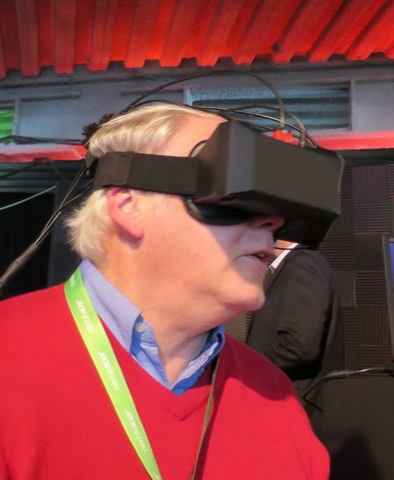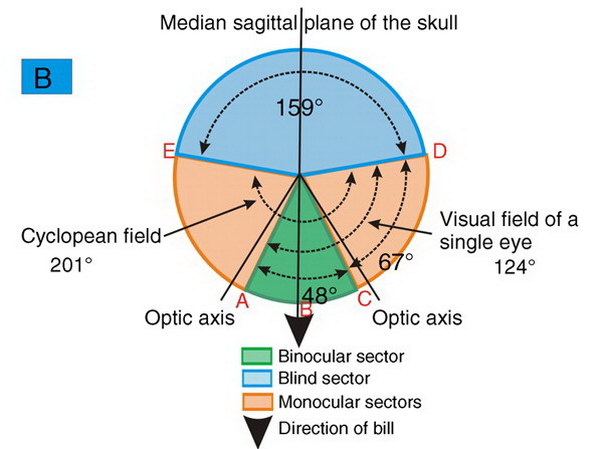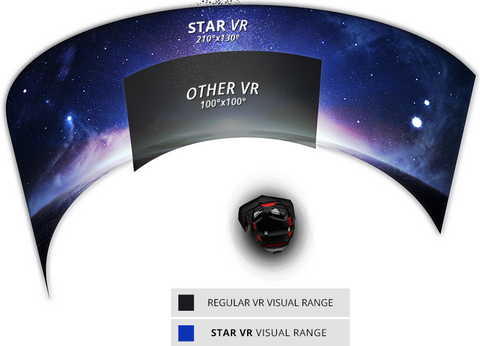At the Next@Acer press conference on April 21, Starbreeze Studios showed its prototype StarVR headset. Starbreeze was founded in 1998 and is an independent creator, publisher and distributor of entertainment products, especially games. Company headquarters are in Stockholm and the company is publicly traded on Nasdaq Stockholm. It has additional studios in Paris and Los Angeles. Initial development of the StarVR headset was done by Infiniteye in Paris, which was acquired by Starbreeze Studios in June, 2015.
In addition to regular gaming content, Starbreeze is working to develop immersive virtual reality experiences, integrating software and hardware in the Project StarVR and the StarVR head mounted display (HMD). While at Next@Acer, I got to talk to Bernard Mendiburu, StarVR Hardware Technologies Director, and Jeanne Carlin, StarVR VP VR Strategic Development. I had previously worked with Mendiburu at Insight Media for thee years on stereoscopic cinema, 3D TV and other 3D applications. His particular field of expertise is in 3D content creation and image quality.
 Matt Brennesholtz wearing the StarVR headset from Starbreeze Studios at Next@Acer. The shape of the headset case is determined by the two displays set at an angle to each other.
Matt Brennesholtz wearing the StarVR headset from Starbreeze Studios at Next@Acer. The shape of the headset case is determined by the two displays set at an angle to each other.
The StarVR headset differs from most other VR headsets in that it uses two LCD displays, one for each eye. Most other VR headsets use a single display and show left and right eye images on different portions of the display. This limits the field of view to about 100° to 120°, according to Mendiburu, and cuts off most of your peripheral vision. This peripheral vision is key to a full sense of immersion in the image.
The StarVR headset uses two 5.5”, high-resolution QHD (AKA Q720p or WQHD, 2560 x 1440) LCD displays, one for each eye. This display resolution works out to 534ppi. The two displays are set at an angle to each other and the optics allow a field of view (FOV) of 210°, more than enough to cover a person’s peripheral vision. In the center of the field of view, the two images overlap and the viewer sees a stereoscopic image. For the peripheral vision, the left display provides the left eye with the left peripheral image and the right display provides the right eye with right peripheral image. Since the left and right eyes see completely different images, the viewer does not see stereoscopic 3D in the peripheral images. This is not a problem for an immersive HMD because this is the way humans see the real world, so it is how they should see a virtual image. The 210° FOV of the StarVR headset, compared to the 201° human FOV, as shown in the figure, allows for motion of the eye without loss of the peripheral image. The vertical FOV of the headset is also larger, 130° for the StarVR and typically 100° for single-display VR headsets.
 Binocular (stereoscopic) and monocular (non-stereoscopic) fields of view for human vision
Binocular (stereoscopic) and monocular (non-stereoscopic) fields of view for human vision
 Comparison of the StarVR FOV to the FOV of other headsets
Comparison of the StarVR FOV to the FOV of other headsets
One major issue with VR is the visible pixelization in the image, also known as the ‘screen door’ effect. The use of two high resolution displays in the StarVR headset noticeably reduced this problem compared to the other HMDs at Next@Acer, the Oculus Vive, the OSVR and the HTC Vive. Even so, pixels were still readily visible in the StarVR headset. Still, it was a dramatic improvement compared to the coarse pixelization seen in smartphone-based VR systems and the reduced pixelization visible in competitor headsets.
According to Mr. Mendiburu and Ms. Carlin, the StarVR headset is still in development and the unit at Next@Acer was not a pre-production model of a commercial unit. Looking at the unit I could see multiple connecting cables and other indicators that this was a proof-of-principle unit, not a true prototype. They declined to discuss either the time frame or the price range for the StarVR headset commercial introduction. They did say that the image quality seen was limited by the headset, not the computer driving the headset, hinting at, perhaps, units with higher resolution displays in the future. They added that VR content usable for competitor headsets with smaller FOVs was viewable on the StarVR headset. This makes sense, since the VR content needs to have a complete 360° FOV and it doesn’t matter (except in terms of computer and GPU power required) whether the headset uses a 210° portion of this content or a 120° portion of the image. Since more pixels are rendered per field than in competitive HMDs, it is especially important for the StarVR headset to be driven by the highest throughput GPU available.
In the past, Starbreeze Studios has run a demonstration RV tour in the US, primarily to get input from users on what they want from VR content and learn about the requirements for VR hardware. The company is planning on opening a permanent public VR Center in the Los Angeles area later this year to get additional input and, of course, show off Starbreeze products. –Matthew Brennesholtz.

